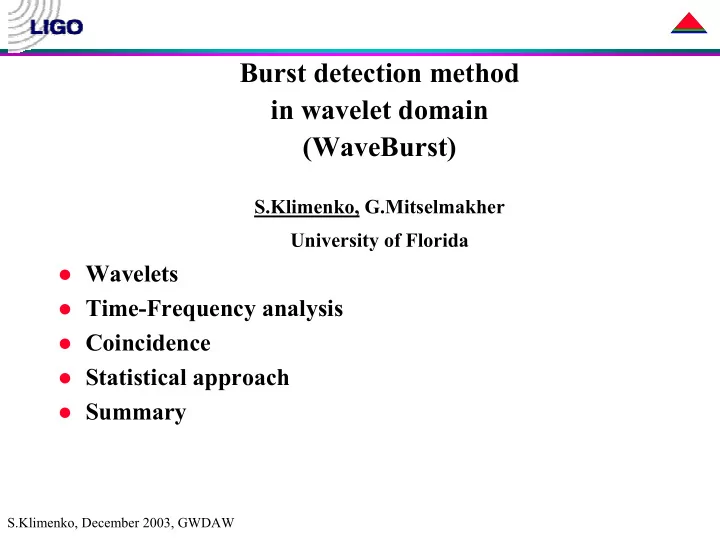

Burst detection method in wavelet domain (WaveBurst) S.Klimenko, G.Mitselmakher University of Florida � Wavelets � Time-Frequency analysis � Coincidence � Statistical approach � Summary S.Klimenko, December 2003, GWDAW
Wavelet basis ( ) basis {Ψ( t )} : � Ψ = Ψ − j / 2 j a a t k � bank of template waveforms jk 0 � Ψ 0 - mother wavelet � a=2 – stationary wavelet Fourier Haar local not orthogonal local not smooth Mexican Daubechies Marr local, hat local smooth, orthogonal not smooth orthogonal wavelet - natural basis for bursts fewer functions are used for signal approximation – closer to match filter S.Klimenko, December 2003, GWDAW
Wavelet Transform decomposition in basis { Ψ (t)} critically sampled linear dyadic DWT d 0 d 0 ∆ fx ∆ t=0.5 LP HP d 1 d 2 d 1 d 3 d 2 d 4 a a a. wavelet transform tree b. wavelet transform binary tree time-scale(frequency) spectrograms S.Klimenko, December 2003, GWDAW
TF resolution d 0 d 1 d 2 depend on what nodes are selected for analysis � � dyadic – wavelet functions wavelet packet – linear combination � constant of wavelet functions � variable � multi-resolution � select significant pixels searching over all nodes and “combine” them into clusters. S.Klimenko, December 2003, GWDAW
Choice of Wavelet wavelet resolution: 64 Hz X 1/128 sec Symlet Daubechies Biorthogonal sg850Hz τ =1 ms Wavelet “time-scale” plane τ =100 ms S.Klimenko, December 2003, GWDAW
burst analysis method detection of excess power in wavelet domain � use wavelets � flexible tiling of the TF-plane by using wavelet packets � variety of basis waveforms for bursts approximation � low spectral leakage � wavelets in DMT, LAL, LDAS: Haar, Daubechies, Symlet, Biorthogonal, Meyers. � use rank statistics � calculated for each wavelet scale � robust � use local T-F coincidence rules � works for 2 and more interferometers � coincidence at pixel level applied before triggers are produced S.Klimenko, December 2003, GWDAW
Analysis pipeline channel 1 channel 2 channel 3,… wavelet transform, wavelet transform, wavelet transform, data conditioning data conditioning data conditioning, rank statistics rank statistics rank statistics bp bp bp “coincidence” “coincidence” IFO1 cluster IFO2 cluster IFO3 cluster generation generation generation “coincidence” bp � selection of loudest (black) pixels (black pixel probability P ~10% - 1.64 GN rms) S.Klimenko, December 2003, GWDAW
Coincidence accept reject no pixels or L <threshold � Given local occupancy P(t,f) in each channel, after coincidence the black pixel occupancy is ∝ 2 P ( t , f ) P ( t , f ) C for example if P=10%, average occupancy after coincidence is 1% � can use various coincidence policies � allows customization of the pipeline for specific burst searches. S.Klimenko, December 2003, GWDAW
Cluster Analysis (independent for each IFO) cluster � T-F plot area with high occupancy Cluster Parameters cluster halo size – number of pixels in the core volume – total number of pixels density – size/volume amplitude – maximum amplitude power - wavelet amplitude/noise rms energy - power x size asymmetry – (#positive - #negative)/size confidence – cluster confidence neighbors – total number of neighbors frequency - core minimal frequency [Hz] band - frequency band of the core [Hz] cluster core time - GPS time of the core beginning positive negative duration - core duration in time [sec] S.Klimenko, December 2003, GWDAW
Statistical Approach � statistics of pixels & clusters (triggers) � parametric � Gaussian noise � pixels are statistically independent � non-parametric � pixels are statistically independent � based on rank statistics: data: { x i }: |x k1 | < | x k2 | < … < |x kn | rank: { R i }: n n-1 1 ( ) η – some function = η ⋅ y ( R ) u x u – sign function i i i example: Van der Waerden transform, R � G(0,1) S.Klimenko, December 2003, GWDAW
non-parametric pixel statistics � calculate pixel likelihood from its rank: R ( ) = − ⋅ y ln i u x i i nP � Derived from rank statistics � non-parametric � likelihood pdf - exponential percentile probability R x i i nP S.Klimenko, December 2003, GWDAW
statistics of filter noise (non-parametric) � non-parametric cluster likelihood R ∑ = k = − Y 0 ln i k nP i � sum of k (statistically independent) pixels has gamma distribution − k 1 − Y Y e k = pdf ( Y ) k k Γ ( k ) P=10% single pixel likelihood y S.Klimenko, December 2003, GWDAW
statistics of filter noise (parametric) � x: assume that detector noise is gaussian � y: after black pixel selection (| x |> x p ) � gaussian tails � Y k : sum of k independent pixels distributed as Γ k 2 2 − x x = y , p α Gaussian noise 2 ( ) − 1 α = + − 2 1 x p − ≈ y P =10% pdf ( y ) e , ∑ k x p =1.64 Υ = y k i 0 y S.Klimenko, December 2003, GWDAW
cluster confidence � cluster confidence: C = -ln (survival probability) ∞ ∫ = − − − k 1 x C ( Y ) ln x e dx 1 Γ k ( k ) Y k � pdf(C) is exponential regardless of k . parametric C parametric C S2 inj S2 inj non-parametric C non-parametric C S.Klimenko, December 2003, GWDAW
Summary • A wavelet time-frequency method for detection of un- modeled bursts of GW radiation is presented � Allows different scale resolutions and wide choice of template waveforms. � Uses non-parametric statistics � robust operation with non-gaussian detector noise � simple tuning, predictable false alarm rates � Works for multiple interferometers � TF coincidence at pixel level � low black pixel threshold S.Klimenko, December 2003, GWDAW
Recommend
More recommend